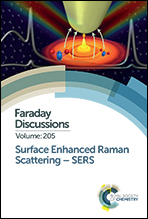Quantitative surface-enhanced Raman spectroscopy of single bases in oligodeoxynucleotides†
Abstract
To address the question of whether the SERS signals of ss-DNA are simply combinations of the signals from the individual bases that comprise the sequence, SERS spectra of unmodified ss-DNA sequences were obtained using a hydroxylamine-reduced Ag colloid aggregated with MgSO4. Initially, synthetic oligodeoxynucleotides with systematic structural variations were used to investigate the effect of adding single nucleobases to the 3′ terminus of 10-mer and 20-mer sequences. It was found that the resulting SERS difference spectra could be used to identify the added nucleobases since they closely matched reference spectra of the same nucleobase. Investigation of the variation in intensity of an adenine probe which was moved along a test sequence showed there was a small end effect where nucleobases near the 3′ terminus gave slightly larger signals but the effect was minor (30%). More significantly, in a sample set comprising 25-mer sequences where A, T or G nucleobases were substituted either near the centres of the sequences or the 5′ or 3′ ends, the SERS difference spectra only matched the expected form in approximately half the cases tested. This variation appeared to be due to changes in secondary structure induced by altering the sequences since uncoiling the sequences in a thermal pre-treatment step gave difference spectra which in all cases matched the expected form. Multivariate analysis of the set of substitution data showed that 99% of the variance could be accounted for in a model with just three factors whose loadings matched the spectra of the A, T, and G nucleobases and which contained no positional information. This suggests that aside from the differences in secondary structure which can be eliminated by thermal pre-treatment, the SERS spectra of the 25-mers studied here are simply the sum of their component parts. Although this means that SERS provides very little information on the primary sequence it should be excellent for the detection of post-transcription modifications to DNA which can occur at multiple positions along a given sequence.
- This article is part of the themed collection: Surface Enhanced Raman Scattering - SERS


 Please wait while we load your content...
Please wait while we load your content...